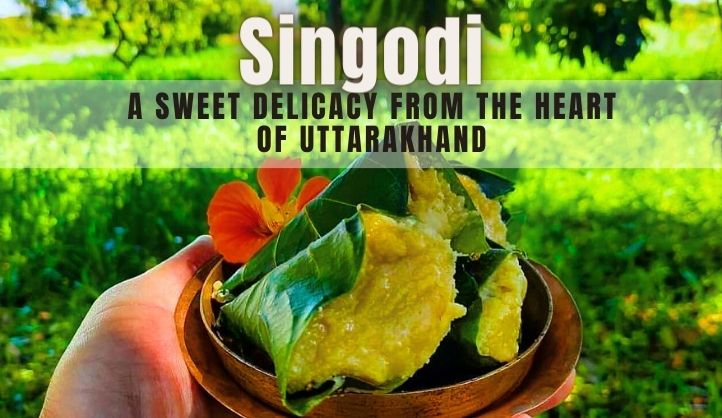Introduction
Nestled in the picturesque hills of Uttarakhand lies a sweet indulgence that captivates the senses and delights the palate. Singodi, a traditional dessert native to the Kumaon region of Uttarakhand, is a culinary treasure cherished for its simplicity and rich flavors. In this article, we embark on a journey to uncover the story behind Singodi and explore the cultural significance of this beloved sweet treat.
The Origins of Singodi
Singodi traces its roots back to the cultural tapestry of Uttarakhand, where it has been enjoyed for generations as a symbol of celebration and tradition. The name “Singodi” is derived from the Hindi word “Singhara,” which refers to the Indian water chestnut, a key ingredient in the sweet’s preparation. This dessert is believed to have originated in the hillside villages of Kumaon, where it was traditionally made during festivals and special occasions.
Ingredients and Preparation
The beauty of this dessert lies in its simplicity, with just a handful of ingredients coming together to create a decadent treat. The primary ingredients include khoya (reduced milk) and grated coconut, which are mixed together to form a smooth and creamy mixture. This mixture is then wrapped in leaves of the Malu tree, which impart a subtle earthy flavor to the sweet.
The process of making this dessert is a labor of love, requiring patience and skill to achieve the perfect balance of flavors and textures. The khoya is cooked slowly over a low flame until it thickens and develops a rich caramelized flavor. The grated coconut is then added to the khoya mixture, enhancing its sweetness and adding a hint of nuttiness.
Cultural Significance:
Singodi holds a special place in the hearts of the people of Uttarakhand, where it is often enjoyed during festivals, weddings, and other joyous occasions. It is considered a symbol of hospitality and goodwill, with families sharing Singodi with their loved ones as a gesture of warmth and affection.
Moreover, Singodi reflects the region’s agricultural heritage, with its use of locally sourced ingredients such as khoya and coconut. The leaves of the Malu tree, used to wrap the Singodi, are also symbolic of the region’s natural beauty and biodiversity.
Savoring Singodi:
The experience of savoring Singodi is a sensory delight, with each bite offering a symphony of flavors and textures. The creamy richness of the khoya melds seamlessly with the sweet and aromatic coconut, while the subtle earthiness of the Malu leaves adds a unique dimension to the sweet.
This dessert is typically enjoyed chilled, allowing the flavors to develop and intensify. It is often served as a dessert or a sweet snack, complementing the richness of Indian meals with its light and refreshing taste.
Conclusion
In conclusion, Singodi is more than just a sweet treat; it is a culinary embodiment of Uttarakhand’s rich cultural heritage and natural abundance. From its humble origins in the hillside villages of Kumaon to its widespread popularity today, this dessert remains a beloved symbol of tradition and celebration.
So, the next time you find yourself craving a taste of the hills, why not indulge in the decadent flavors of Singodi? It’s a journey worth taking, one bite at a time.
FAQs About Singodi
What is Singodi?
Singodi is a traditional sweet delicacy from the Kumaon region of Uttarakhand, India. It is made from a mixture of khoya (reduced milk) and grated coconut, wrapped in leaves of the Malu tree, and enjoyed as a dessert or sweet snack.
How is Singodi prepared?
This dessert is prepared by cooking khoya over a low flame until it thickens, then mixing it with grated coconut to form a smooth mixture. This mixture is then wrapped in Malu tree leaves and allowed to set before serving.
What does this dessert taste like?
This dessert has a rich and creamy texture, with a combination of sweet and nutty flavors. The khoya lends a caramelized sweetness to the dish, while the grated coconut adds a hint of nuttiness. The Malu tree leaves impart a subtle earthy flavor to the sweet.
Can Singodi be stored?
Yes, this dessert can be stored for a few days in the refrigerator. It is best enjoyed chilled, allowing the flavors to develop and intensify over time. Simply wrap the Singodi in plastic wrap or store it in an airtight container to maintain its freshness.
Is this dessert a popular dish outside of Uttarakhand?
While this dessert is primarily enjoyed in the Kumaon region of Uttarakhand, it has gained popularity across India and among Indian communities worldwide. Its unique flavor and cultural significance make it a sought-after delicacy for those seeking to experience the diverse culinary traditions of India.





